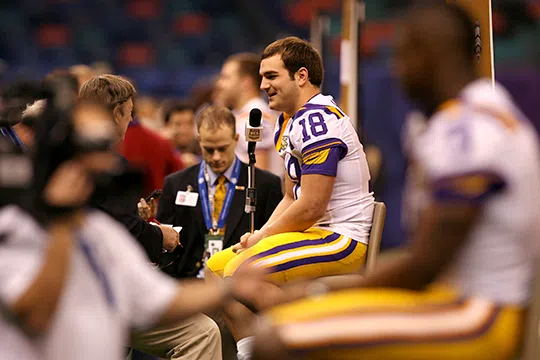By Jacob Hester
There’s no time in your football career quite like the stretch between your last college game and the moment you hear your name called in the NFL Draft. We used to call it “draft purgatory.”
As football players, there’s always been a rhythm — no matter what level you play at. You finish your season, take a short break, and then it’s back to work. Winter conditioning kicks off, prepping your body for the rigors of spring football. After spring ball, there’s a short breather, and then summer strength and conditioning begins.
You know what’s coming: eight weeks of grueling training, where coaches push you to your mental and physical limits, testing how far they can stretch you without breaking you. It’s a cycle — rinse, wash, repeat — year after year.
But this time, that cycle breaks.
For the first time in your football life, you step into something completely unfamiliar — a world of 40-yard dashes, medical evaluations, interviews, and a whole lot of waiting.
For me, it all started the morning after we won the national championship against Ohio State on January 7, 2008. While most people were still celebrating, we were already packing.
On January 8, we boarded a flight to Phoenix, Arizona, to begin NFL Combine training at API, located at Arizona State.
Because our bowl game had been so late, most guys in my draft class were already ahead in their prep. I had to play catch-up.
Training wasn’t just about workouts. It was about mastering the schedule: training, recovery, nutrition, sleep. Every minute was accounted for. Just as I was getting into a rhythm, it was time to catch another flight—this one to Mobile, Alabama, for the Senior Bowl.
It was a total mental shift. After two weeks of focusing on combine drills, better known as the “underwear Olympics,” it was finally time to get back to real football.
Pads. Playbooks. Live competition.
The Senior Bowl is one of the most intense weeks in the entire pre-draft process. It’s not just about your performance on the field, it’s about showing NFL decision-makers how badly you want this. They want to see what you’re willing to sacrifice and how you handle pressure.
After one final game in Mobile, it was straight back to Phoenix to resume combine prep.
At a place like API, you’re working with the best of the best. Our speed coach was a former Olympic track coach. Every drill was broken down to a science. Every detail was focused on shaving off tenths of a second from your 40-yard dash.
We trained three times a day, dialing in everything, from start mechanics to interview prep. The Combine wasn’t just a physical test, it was a mental gauntlet.
You’d think once you leave Indianapolis, the pre-draft process is over. It’s not.
Now, it’s time to gear up for Pro Day.
Pro Days are staggered and each school has its own date. So, guys start peeling off from the training group and heading back. We’d all stay in touch, checking in:
“Did he run a faster 40?”
“How were they on field drills?”
“How’d he catch the ball this time?”
And eventually, it was my turn.
At LSU’s Pro Day, I focused on showcasing my on-field ability. I was happy with my Combine numbers, so it was about proving I could translate that into real football.
When it wrapped up, the real waiting began.
There’s a strange stillness after Pro Day. You’ve been going nonstop. Training, traveling, competing and then it just…stops.
You start asking yourself: What now?
You’ve put in all this work, but there’s no clear direction. What should I be working on? What kind of system will I be in? Do I just keep focusing on fundamentals and hope it carries over?
Eventually, you go back to what you’ve always done. You put your head down and work.
Some guys get team visits. I was fortunate and the San Diego Chargers called my agent and invited me in as one of their top fullback prospects.
It gave me a glimpse into a possible future with a team, a city, and maybe even a new home for my family.
That’s another part of the process no one talks about. In college, you get to choose where you go. In the NFL? You have zero control.
You could end up in 10-degree Buffalo or sunny San Diego. Low cost of living in New Orleans or sky-high taxes in San Francisco. It’s not your decision, it’s a front office call.
By the time the draft arrives, you’re over the buildup. You’re done with the flights, the interviews, the speculation.
Just tell me the team, hand me a helmet, shoulder pads, maybe even a neck roll and let me get back to doing what I love, which is playing the game, on an actual football field.
The real game.
With teammates.
With coaches.
With a specific scheme and a purpose.
And once you get there? Don’t expect a break. You’ve got 32 straight weeks of grind ahead before your first real breather.
Buckle up, rook—it’s about to get real.





